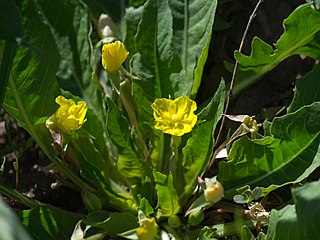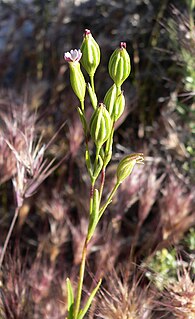
Platystemon is a monotypic genus of flowering plants in the poppy family containing the single species Platystemon californicus, which is known by the common name creamcups. It is native to Oregon, California, Arizona, Utah and Baja California, and is found in open grasslands and sandy soils below 6,000 feet (1,800 m) elevation.

Phoenicaulis is a monotypic genus of flowering plants in the family Brassicaceae. It contains the single species Phoenicaulis cheiranthoides, which is known by the common names daggerpod and wallflower phoenicaulis.

Spergularia rubra, the red sandspurry or red sand-spurrey, is a plant species in the family Caryophyllaceae. It is native to Europe, Asia and North Africa, and it is present on other continents, including North and South America and Australia, as an introduced species and in many areas a common weed. It grows in a wide variety of habitat types.

Lepidium nitidum, known by the common name shining pepperweed, is a species of flowering plant in the mustard family.

Camissoniopsis bistorta is a species of flowering plant in the evening primrose family known by the common names southern suncup and California suncup. It is native to southern California and Baja California, where it grows in several types of plant community along the coast and in the coastal hills and mountain ranges. This is a hairy annual or perennial herb spreading from a basal rosette with stems reaching up to 80 centimeters long. Leaves are lance-shaped to narrowly arrowhead-shaped and sometimes toothed, and 1 to 12 centimeters in length. Toward the end of the spreading stems are nodding inflorescences of flowers, each flower with four bright yellow petals dotted with red at their bases. At the center are stamens and a protruding, nearly spherical stigma. The fruit is a straight or slightly coiled capsule up to 4 centimeters long.

Calochortus tolmiei is a North American species of flowering plant in the lily family known by the common names Tolmie's star-tulip and pussy ears. It was discovered by and named for Dr. William Fraser Tolmie.

Camissonia contorta is a species of evening primrose known by the common name plains evening primrose. It is native to western North America from British Columbia to California to Idaho, where it grows in many habitat types. It is an annual herb producing a slender, bending to curling red or green stem which is sometimes hairy. It is up to 30 centimeters long and erect or spreading out. The blue-green leaves are linear to very narrowly oval in shape and up to 3.5 centimeters long. The nodding inflorescence produces one or more small flowers. Each has bright yellow petals up to half a centimeter long, sometimes with small red dots near the bases. The fruit is a capsule about 3 centimeters long containing shiny seeds.
Chylismiella pterosperma is a species of evening primrose known by the common name wingfruit suncup and is the only species in the monotypic genus Chylismiella. It is native to the western United States, where it grows in several habitat types, including sagebrush. It is a slender annual herb producing an erect stem up to about 14 centimeters in height. The leaves are up to 3 centimeters long and densely coated in bristly hairs. The nodding inflorescence produces flowers with white petals each less than 3 millimeters long. They are sometimes yellow near the bases and fade to a purple color as they wither. The fruit is a straight capsule about 1 to 3 centimeters long with a thick wing down the middle.

Taraxia subacaulis is a species of evening primrose known by the common name diffuseflower evening primrose. It is native to the western United States, where it grows in several habitat types, especially in mountainous areas. It is a fleshy perennial herb growing from a taproot and usually lacking a stem. The leaves are lance-shaped to oval and up to 22 centimeters long and are borne on long petioles. The flower has yellow petals, each up to 1.5 centimeters long, and a large, bulbous stigma tip. The fruit is a leathery capsule 1 to 3 centimeters long.
Epilobium foliosum is a species of flowering plant in the evening primrose family known by the common names leafy willowherb and California willowherb. It is native to parts of western North America from British Columbia through California to Arizona, where it grows in many types of habitat, including disturbed areas.
Epilobium oregonense is a species of flowering plant in the evening primrose family known by the common name Oregon willowherb. It is native to western North America from British Columbia to Arizona, where it generally grows in moist places in several types of habitat. It is a perennial herb growing spindly erect stems approaching 40 centimeters high or sometimes forming mats spreading via stolons. The small leaves are rounded near the base of the plant and linear in shape farther up the stem. The inflorescence bears flowers with four white to pink petals each a few millimeters long. The fruit is an elongated capsule up to 5 centimeters in length which is borne on a long pedicel which may be longer than the capsule itself.

Mentzelia dispersa is a species of flowering plant in the family Loasaceae known by the common name bushy blazingstar. It is native to western North America from British Columbia to California to the Dakotas, where it grows in many types of habitat.

Mesembryanthemum nodiflorum is a species of succulent plant in the genus Mesembryanthemum known by the common name slenderleaf iceplant. It is the type species for the genus. It is native to Israel, Palestine, and Jordan, as also endemic to southern Africa. It is also native to Croatia on the island of Palagruza in the Adriatic Sea, which is its northernmost habitat, but it is known in many other places as an introduced species and sometimes an invasive weed, including several regions of Australia, parts of the western United States and adjacent Mexico, and some Atlantic islands.

Silene antirrhina is a species of flowering plant in the family Caryophyllaceae known by the common names sleepy silene and sleepy catchfly. It is native to the Americas, where it is widespread throughout North America and parts of South America. It is known in Europe as an introduced species.

Silene bernardina is a species of flowering plant in the family Caryophyllaceae known by the common name Palmer's catchfly.

Silene lemmonii is a species of flowering plant in the family Caryophyllaceae known by the common name Lemmon's catchfly.
Stanleya elata is a species of flowering plant in the family Brassicaceae known by the common name Panamint princesplume. It is native to the desert mountains of eastern California and western Nevada, where it grows in rocky and scrubby habitat types. It may also occur in Arizona. It is a perennial herb producing one or more erect stems reaching about 1.5 meters in maximum height. They are hairless and often waxy in texture. The thick, leathery leaves have lance-shaped or oblong blades with smooth or toothed edges measuring up to 15 centimeters long. They are borne on petioles. The top of the stem is occupied by a long inflorescence which is a dense, snaking raceme of many flowers. Each flower has four narrow, threadlike yellow or whitish petals each about a centimeter long and a millimeter wide. The fruit is a long, thin, wormlike silique which may be 10 centimeters in length. It contains tiny seeds.

Stanleya pinnata is a species of flowering plant in the family Brassicaceae known as desert princesplume. It is native to North America.

Streptanthus cordatus is a species of flowering plant in the mustard family known by the common name heartleaf twistflower. It is native to the western United States, where it can be found in many types of sagebrush, woodland, and forest habitat. It is a perennial herb producing a branched or unbranched stem up to about a meter tall. It is often waxy in texture. The basal leaves are oval or spoon-shaped with bristle-toothed blades borne on rough-haired petioles. Leaves higher on the stem are oval to lance-shaped, up to 9 centimeters long with their bases usually clasping the stem. Flowers occur at intervals along the upper stem. Each has a calyx of sepals roughly a centimeter long which begin greenish yellow and mature purple. Four purple petals emerge from the tip of each calyx. The fruit is a thin, narrow silique which may reach 14 centimeters in length or longer.

Tropidocarpum gracile is a species of flowering plant in the family Brassicaceae known by the common name dobie pod. It is native to California and Baja California, where it can be found in many types of habitat from coastal canyons to inland mountains and deserts in chaparral, scrub, woodlands, beaches, valleys, and washes. It is an annual herb producing a decumbent to erect, spreading, branching stem 10 to 50 centimeters in length. It is coated in short and long rough hairs. The basal leaves are up to 10 to 15 centimeters long and are divided into elongated lobes along the edges; leaves higher on the stem are shorter and sometimes less divided. The inflorescence is an open raceme of mustardlike flowers with four petals each about 4 millimeters long. The petals are yellow and sometimes purple-tinged. The fruit is a narrow silique several centimeters in length containing tiny brown seeds.
















